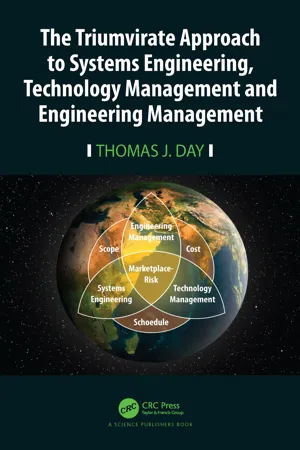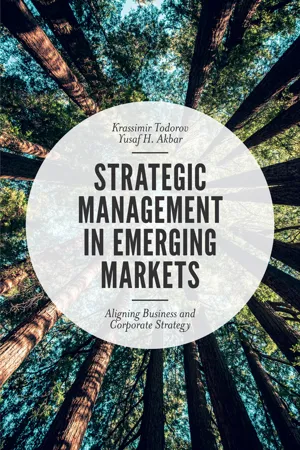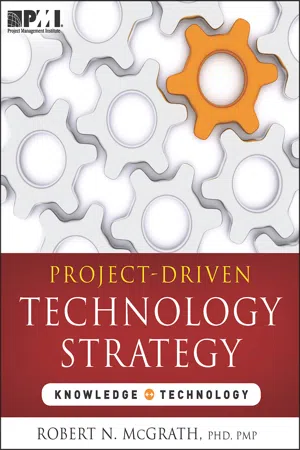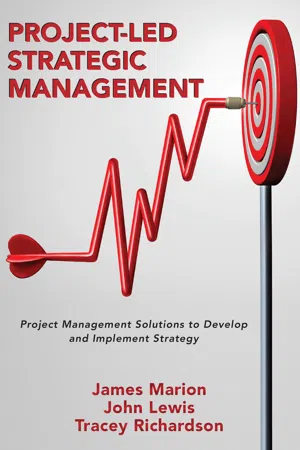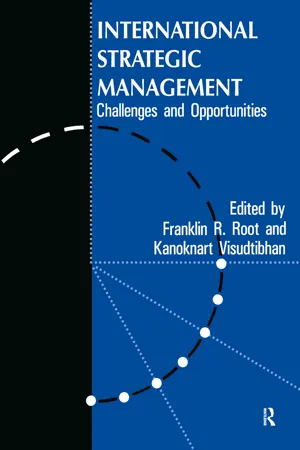Technology & Engineering
Strategic Management
Strategic management involves the formulation and implementation of long-term goals and initiatives to achieve organizational success. It encompasses analyzing the internal and external environment, setting objectives, and devising strategies to attain competitive advantage. In the context of technology and engineering, strategic management is crucial for aligning technological capabilities with business objectives and adapting to dynamic market conditions.
Written by Perlego with AI-assistance
Related key terms
Related key terms
1 of 4
Related key terms
1 of 3
12 Key excerpts on "Strategic Management"
- eBook - ePub
Technology in Context
Technology Assessment for Managers
- Ernest Braun(Author)
- 2005(Publication Date)
- Routledge(Publisher)
Strategic Management of technology means the planning of the development or acquisition of production technologies and of products with the right technological features, to fit in with the general strategic plan of the firm. Strategic technology management also means implementing the longer term technological plans. It does not mean the day-to-day running of production or maintenance, which falls onto the shoulders of technology line management.When we speak of a firm, we do not necessarily mean a large conglomerate, but what amounts to a separate business, even if it is a strategically almost autonomous sub-unit of a larger firm. We note in passing that the division of the firm into strategic units (or cost centres, or business units) usually occurs on the basis of two criteria: the product-markets the unit serves, and the technology it employs. Each business unit should have a homogeneous set of key factors for success and, at least in manufacturing industry, technology invariably is a key factor (Dussauge et al. 1992, 26–33).Properly we should deal with the Strategic Management of production technology and of products as separate issues. Indeed, product planning is only in part an issue of technology; many aspects of product planning are the concerns of design, marketing, production capacity, competition, and coherence of product policy. To some writers on technology management, the technology of the greatest strategic significance is production technology. Bessant speaks of manufacturing strategy as an important component of business strategy, and regards production technology as a crucial aspect of manufacturing strategy.Manufacturing strategy is primarily concerned with how the products will be made, or the services delivered, and includes factors such as: choice of process or technique; make or buy decisions; setting quality standards and procedures; production and work organization; requirements for physical facilities (buildings and services); design of planning and control systems; investment plans and justification. One of the most significant tools in manufacturing strategy is technology, the combination of equipment, software and organization which facilitates manufacturing. - eBook - ePub
- Thomas J. Day(Author)
- 2022(Publication Date)
- CRC Press(Publisher)
CHAPTER 4 The Technology Strategy ProcessA good execution of any technology undertaking cannot take place without a good technology strategy. The better the strategy, the better the execution will be, the more likely innovation will remain focused and the greater the likelihood success will be the result of the activity. In order to develop a good strategy in technology development, specific considerations must be accommodated unique to this class of projects. The pressures of corporate stockholders, limited resources and other competitive challenges requires that extraordinary means must be taken to ensure prime technology development. By combining the Systems Engineering approach with the reporting function of Project Management, those specific concerns can be addressed to a successful end result.The Technology Strategy
Once a clear vision is generated on how the technology is to be implemented and how it should operate and behave, then a set of requirements can be defined to build and develop the technology use. The next step is to have a strategy to reach the endpoint desired through the development of a plan. Figure 4.1 broadly outlines these areas of development for this stage in the technology activity.Figure 4.1: Defining technology development parametersThe standard Project Management approach would be to develop scope, budget risk and project plan. What is generally not discussed is how such things are created. There are some methodologies included in the various project management training certifications, but few go into depth on how such approaches are to be built, used and analyzed.The three areas in Systems Engineering that need to be considered and addressed at this stage of technology development are:- Analysis of Alternatives (A0A) – Where the best solution is chosen from a short list of identified alternatives. Alternatives are classified by the project management as best practice of cost/scope/time to develop and best solution to the problem or desired goal using the Systems Engineering approach of fit, form and function79
- eBook - ePub
- Krassimir Todorov, Yusaf H. Akbar(Authors)
- 2018(Publication Date)
- Emerald Publishing Limited(Publisher)
3
Basics of Strategic Management
Strategic Management and Strategic Planning
Strategic Management
The Strategic Management process is a sequential set of analyses and choices that can increase the likelihood that a firm will choose a good strategy that is a strategy that leverages sources of competitive advantage (Barney & Hesterly, 2012, p. 4). The fundamental question in the field of Strategic Management is: How firms achieve and sustain competitive advantage? (Rumelt, Schendel, & Teece, 1994). The purpose of Strategic Management is to “elicit the present actions for the future” and become “action vehicles – integrating and institutionalizing mechanisms for change” (Kanter, 1984).The concept of “Strategic Management” did not become firmly established in business thinking until the early 1970s, where after years of economic growth and worldwide sales of mass, standardized products, there was clear evidence that markets were becoming saturated and at the same time, people had recognized the finite nature of natural resources (Spremann & Schwenker, 2009, p. 88). According to Ansoff, Strategic Management is a systematic approach for managing strategic change, which consists of the following:- Positioning the firm through strategy and capability planning.
- Real-time strategic response trough issue management.
- Systematic management of resistance during strategy implementation.
Strategic Management can also be defined as the art and science of formulating, implementing, and evaluating cross-functional decisions that enable the organization to achieve its objectives (David, 2011, p. 6). Strategic Management issues are invariably ambiguous and unstructured, and the way in which management responds to them determines whether an organization will succeed or fail (Wright, Kroll, & Parnell, 1998, p. 3). Strategic Management is primarily concerned with (Burns, 1992): - eBook - ePub
- Robert McGrath, PMP, EVP, MBA(Authors)
- 2012(Publication Date)
- Project Management Institute(Publisher)
Vision and Mission Terms of Value Value Value Added Value Chains Supply Chains Monopoly and Market Power Summary Chapter 5 Takeaways Questions for Discussion Chapter 5 Appendix Competitive AdvantageIntroductionAs a field of academic study, Strategic Management has not been around as long as many others. A watershed decade was the 1960s, when it became clear that business schools were graduating individuals who were properly skilled at fundamentals such as finance and accounting, economics, and marketing, but they lacked the ability to integrate these skills into a cohesive view of the organization.Business schools began to insist that degree programs include content that provided this exposure and skill-set. What evolved was a body of research, scholarship, and theory that today is called Strategic Management. This corpus helped popularize many terms, including Strategic Management, competitive advantage, core competencies, vision, mission, and economic value added. So in order to develop a working framework for developing a project-driven technology strategy, we first need to explain some elemental concepts.Strategic Management Theory and TechnologyTechnological innovation is important to business, industry, and economic success (Baden-Fuller & Stopford, 1994; Betz, 1987, 2003; Burgelman & Sayles, 1986; Freeman, 1990, 1994; Kanter, 1983; Marceau, 1994; Pinchot, 1985; Roberts, 1991; Rostow, 1994). Therefore, it must be managed strategically.Strategic Management owes most of its pedigree to several broad research traditions: industrial organization (and neoclassical economics in general), marketing, and administrative behavior (organizational behavior, organizational theory, psychology, and political science) (Jemison, 1981). The impact of economics (Barney, 1997; Besanko, Dranove, & Shanley, 2000; Porter, 1985; Tirole, 1990) has possibly been the most profound, but its treatment of technological innovation and change has usually been problematic (Sako, 1994). - eBook - ePub
- Susanne Ferch, Michael Roe(Authors)
- 2019(Publication Date)
- Routledge(Publisher)
A second section invites the reader for a short historical journey through the evolutionary process of the theory of Strategic Management. The aim is to understand how the focus of theoretical research not only changed over time, but how the tools and techniques that have been employed have become more complex and sophisticated in an attempt to capture the high complexity of the fast-changing business environment. In the next section the process of strategy making is explored in some depth: this includes consideration of mission statement, audit, strategic choice, implementation and control. Additionally, Strategic Management tools and techniques used in each step of the process are presented and analysed. Section four relates Strategic Management to the port industry and port authorities and addresses the question whether ports can benefit from this type of management and looks at the potential usage of Strategic Management in different business contexts. This chapter concludes by assigning each level of environmental turbulence to a specific Strategic Management system.Definitions and basic concepts
Strategy defined
Strategy is of Greek origin meaning “the art of warfare” (Duden Fremdwoerterbuch 1966). As the twentieth century comes to an end and the 21st century approaches, the commercial and organisational battle is beginning to be fought on different grounds - including market share and the like - and it is now company directors who are asking the four questions of strategy:- 1) Where are we now?
- 2) Where do we want to be in the future?
- 3) How do we get there?
- 4) How do we assure safe arrival?
Question number one is concerned with the analysis of the present state of the organisation and its environment. Question number two deals with the mission and goals of the firm. The third question is about formulating ideas concerning the set of actions that may lead to the achievement of missions and goals, evaluating the alternatives and finally choosing which one or ones that are most appropriate. The fourth question addresses the issue of implementation and control of strategies (see Fifield and Gilligan 1995:XEI). Strategies - understood in a narrower sense - can be defined as the means, or the set of actions that are or need to be taken to achieve the organisational goals of the company or authority that is under examination (Koontz 1992, David 1995).What then is Strategic Management and how does it differ from other types of management?Strategic Management defined
Management is, according to Koontz and Weihrich (1990:4), the“process of [creating] an environment in which individuals, working together in groups, efficiently accomplish selected aims” As such it involves passing through a number of stages including those of planning, organising, staffing, leading and control. Strategic - eBook - ePub
Construction Management
New Directions
- Denny McGeorge, Patrick X. W. Zou(Authors)
- 2012(Publication Date)
- Wiley-Blackwell(Publisher)
While mission is the reason why an organisation exists and vision is the ideal state of the organisation in the future, strategy defines how to get towards the ‘ideal’ state described in the vision statement. According to De Wit and Meyer [6], there are three interactive dimensions of a strategy: strategy context, strategy contents and strategy process, where the strategy process also includes strategic analysis, strategy formulation and strategy implementation. Strategic Management is a combination of managerial decisions and actions that determines the long-term performance of an organisation. Strategic Management can be interpreted in different ways from different perspectives. An organisation’s ability to align resources and activities with strategic objectives should result in success in the business [7].The field of Strategic Management has grown quickly since its formal inception in the late 1970s and is now both broad and diverse in terms of its coverage [8]. Strategic Management experienced a theoretical renaissance of sorts during the 1980s with the most notable contributors being: (1) Porter’s [9−11] five-force framework of industry effects; (2) Williamson’s [12, 13] model of transaction cost economics; and (3) Wernerfelt’s [14] resources-based view on firm-specific qualities. Porter’s five-force framework − buyer power, supplier power, threat of new entrants, product substitution and jockeying for position − can be used to understand the structure of an industry and is a useful analytical tool for assessing an industry’s attractiveness and facilitating competitor analysis. The main focus of Porter’s model was the environment and its relationship to a firm. Williamson’s transaction cost economics theory explains why firms exist in different forms and highlights the relationship between the multidivisional structure and the firm’s performance. One such example is strategic partnering (alliancing) or a joint venture for international modes of market entry. Wernerfelt’s resources-based theory focused on the relationship between a firm’s resources and performance, and includes the resource-based view of the firm, dynamic capability and a knowledge-based approach. Built on to the resource-based theory of competitive advantage came the development of the theory of invisible assets and competence-based theories of corporate diversification. - eBook - ePub
- Carol Cardno(Author)
- 2012(Publication Date)
- SAGE Publications Ltd(Publisher)
Educational leaders who are committed to providing the most effective environment for student achievement could seriously consider the advantages offered by a Strategic Management approach to change and improvement. There is a considerable body of knowledge and skills associated with Strategic Management and it is most effectively accomplished when strategic thinking, strategic analysis, strategic planning and strategic review are being practised in an integrated way. At the heart of Strategic Management is the notion of planning for both the short and long terms. Strategy is the long-term direction of the organisation and is often associated with the term strategic leadership. Strategic Management, according to Johnson and Scholes (2002) is the management of the process of strategic decision-making. It is concerned with deciding on strategy and planning how that strategy will be put into effect. These authors have depicted the nature of Strategic Management activity in a model which illustrates the key elements and the interrelationships between them.The model (Figure 8.1 ) consisting of the elements that constitute strategic activity (Johnson and Scholes, 2002) depicts the iterative nature of strategic activity with the core activities being threefold:- The establishment of a strategic position which requires understanding and analysing the environment; clarifying expectations and purposes of the organisation; and assessing the resources and capabilities that the organisation can commit to achieving its strategic direction.
- Making strategic choices (based on being fully informed about its strategic position) which involves institution-wide corporate level strategies; and units developing their own business-level strategies; and consideration of what needs to be developed and how, in order for the organisation and its parts to achieve their chosen strategy.
- Turning strategy into action which depends on effective management of change; motivation and support that enables the implementation of changes; and careful organisation of the structures and processes that will sustain the changes.
Figure 8.1 A model of the elements of Strategic Management (source: G. Johnson and K. Scholes, 2002, p. 17 , Exploring Corporate Strategy, Texts and Cases, reproduced with the permission of Pearson Education)
The elements of the model are interlinked, and do not necessarily follow a clear path which is a feature of Strategic Management. So, in practice, many activities may occur simultaneously, or as Johnson and Scholes (2002) describe it: ‘One way of understanding a strategy better is to implement it, so strategic choices and strategy into action may overlap. Similarly, an understanding of the strategic position may be built up from the experience of strategy in action’ (p. 353). - eBook - ePub
Project-Led Strategic Management
Project Management Solutions to Develop and Implement Strategy
- James Marion, John Lewis, Tracey Richardson(Authors)
- 2021(Publication Date)
- Business Expert Press(Publisher)
PART 1 How Project Management Fits in Strategic ManagementProject management has long been viewed through the lens of technical management. From its formal beginnings in Department of Defense projects in the 1950s, project management practices have continued to fill the need for a comprehensive set of processes that aid managers in dealing with the natural complexity associated with product, technology, and systems development. Consistent with this view is the observation that many schools continue to offer project management degree programs from within schools of engineering or information technology. What gets lost in the “project management as technical management” perspective is the natural fit observed between project management practice and the process of strategy formulation and implementation. An understanding and appreciation of this fit may be developed by clarifying how the elements of project management practice align with the generally accepted practices of Strategic Management. It could be argued that the analysis, formulation, selection, and implementation of strategy are naturally complex in much the same way as technology projects. Strategy is the result of the firm attempting to make sense of the chaotic macroenvironment and to marshal the moving pieces of the company to attain and to maintain a competitive advantage. This complicated effort requires the close management that project management practice can provide (Figure 1 ).What Is a Project?Figure 1 Strategic planning versus technical projectsA project, by formal definition, is a temporary endeavor that is unique, has a defined beginning and end, is complex, employs resources, and produces deliverables. Project management is the application of practices that seek to ensure that the required project deliverables are produced with the appropriate scope, on schedule, and within the constraints of the budget. The simple definitions of project and project management betray little evidence of its historical placement within the domain of R&D and technical management. Yet, the roots of project management are planted firmly where the processes are deemed to pay the largest dividends. The creation of technologically complex deliverables is characterized by a high degree of uncertainty thereby requiring intensive management focus and novel management methodologies. Further, research and development endeavors are often described as exercises in discovery that may fail to converge in the absence of close management. In the information technology domain, software and system development efforts include components that must be identified, specified, developed, and integrated. Such activity occurs in the context of moving targets that take the form of changing standards, shifting client requirements, and intangible work products. It may be argued that a systematic framework of processes created for producing deliverables naturally emerged within environments that included high technical difficulty, complexity, intangibility, and uncertainty. At the same time, it is observed that many other management endeavors can be complex and involve significant uncertainty. Project management therefore has gained a foothold in nontechnical yet complex and uncertain management environments. - eBook - ePub
An Introduction to Corporate Environmental Management
Striving for Sustainability
- Stefan Schaltegger, Roger Burritt, Holger Petersen(Authors)
- 2017(Publication Date)
- Routledge(Publisher)
Part 3Strategic environmental managementStrategic environmental management is ‘the positioning of a business to take advantage of environmental challenges. It is the attempt to make these challenges into profit-making opportunities rather than threats that curtail business operations and prospects’ (Marcus 1998: 5).The term ‘strategy’ has a military origin. In Greek it describes the ‘art of commanding the army’ (stratós, army; agein, commander). Strategy defines conditions related to entry into the fray, conditions relating to sustaining the position in the dispute and conditions as to when to leave, or exit. It is dependent on the expected strategy of opponents or competitors and anticipates long-term possibilities in a dispute (Kreikebaum 1993: 25). Strategy contrasts with tactical or operational procedures—which are followed when a given strategy is determined.In the middle of the last century the term ‘strategy’, like many other military metaphors, entered the vocabulary of management. Strategic command of a business is also based on anticipation. It is centred on the strategies of competitors, on trends in demand for products and services and development of markets. To evaluate market development in a comprehensive way, strategic command considers additional stakeholders with a claim on the business (e.g. shareholders and non-governmental organisations [NGOs] as well as competitors and customers). Moreover, it highlights the various spheres of the business—political, legal, economic, technological and so on. Nearly every management decision has long-term implications—research, the building of new capacity, the development of new marketing organisations—and managers have to be skilled in making decisions for the long term on a systematic basis (Drucker 1973: 121).Strategic procedure aims at building the potential for success. Potentialities for success are enhanced through early acquisition of competences (inimitable, rare and non-substitutable) and technologies as a basis for grasping future market opportunities (Gälweiler 1990: 24ff.; Marcus 1998: 1). The long-term strategic perspective is evident: for instance, in the case of petroleum companies that are anticipating technological and legal changes in support of the development of the future mass market for regenerative energy products. If environmentally oriented goals are integrated into strategic processes, the potential for successful environmental management increases. Successful environmental management leads to reduced environmental impacts from the activities of a business associated with entry, maintenance and exit from markets. For this reason, the strategic process is scrutinised more closely in Chapter 12 . Basic strategies for handling environmental claims from stakeholders arise from this process (see Chapter 13 ). In Chapter 14 the competitive market strategies for dealing with these claims are examined. Management of environmental risk is a critical component in strategy; risk strategies are considered in Chapter 15 - eBook - ePub
International Strategic Management
Challenges And Opportunities
- Franklin R. Root, Kanoknart Visudtibhan(Authors)
- 2023(Publication Date)
- Routledge(Publisher)
The authors argue that technology for all its vital importance to a global company, cannot be treated as a profit centre. This is part of the difficulty in implementing the technology management function, especially in multidivisional and global firms. They believe that use of this framework will make it easier to integrate technology development into the strategic planning process. In addition it will serve to integrate managers from different parts of the company into a formalized technology planning exercise.Introduction
The need to incorporate the technological dimension in the strategic planning function of the firm has long been recognized as crucial in a globally competitive environment. But company practice and the scholarly literature have lacked a standard paradigm. Many companies feel that there is a poor coupling between technology development and strategic planning, possibly due to a lack of adequate planning frameworks for technology.According to a Booz-Allen and Hamilton survey of 800 U.S. executives, two-thirds felt their companies were making inadequate use of their technologies in the strategic development of the firm (Ford, 1988 ). Among the reasons was the divisionalization of companies which tends to compartmentalize and fragment technology strategy. Some product divisions may not be aware of valuable technologies available from other divisions; the problem is often acute when units of a transnational firm are geographically and administratively scattered in distinct regional or national profit centres. The management of technology—that is to say, its development, transfer and optimal utilization in the multinational firm—is a function that cuts across the product as well as the geographic dimensions of the company. Increasingly, technology needs to be developed and used by more than one product group or nation for maximum efficiency and exploitation. Moreover, a typical technology cycle from research to commercialization takes about ten years whereas a normal corporate planning cycle is three to five years; finally, the R&D function may be overly centralized.Reprinted by permission of Basil Blackwell Ltd. from R&D Management, 20, 4, 1990.A planning framework should address the following concerns. First, the Research and Development process can no longer be considered sequential, but rather synchronous with global manufacturing and global marketing decisions (Takeuchi and Nonaka, 1986 ). This calls for an enlarged role for the R&D manager. But most firms are organized with regions or global product divisions as profit centres (Chandler, 1986 ; Porter, 1986 - eBook - ePub
Frontiers of Management (Routledge Revivals)
Research and Practice
- Roger Mansfield(Author)
- 2014(Publication Date)
- Routledge(Publisher)
Section Two Technology and InnovationPassage contains an image Chapter six Strategic Management in the Innovating Firm K. Pavitt Introduction
In this chapter, I shall present what I think we know, and what we need to know, about the Strategic Management of technology in the business firm. I shall concentrate on the links between technology and business strategy: in other words on those technology-related activities central to the long-term survival of the firm, ranging from the continuous improvement of existing products, processes and services; through the introduction of new ones; to activities designed to enter new fields.After putting the present spate of interest in the subject in its historical perspective, I shall argue that four of the observed characteristics of technological development — functional and professional specialization, uncertainty, cumulative development, and path dependency — offer important guideposts, both for managerial practice, and for further theoretical and empirical research on the subject. I shall further argue that progress in this research has been hindered by the myths and rituals constructed in various academic subdisciplines. Nonetheless, we can now say with some confidence the following three things about technological strategies in firms.First, the choices normally presented about the content of a firm’s technological strategy — broad front versus specialized, product versus process, leader versus follower — are heavily constrained by both the firm’s size and its core business. Technologically active firms that have specialized strategies are typically small and oriented towards products, often developed with strong feedback from large and technically sophisticated users. Large firms typically have broad front strategies, with one major path being horizontal diversification emerging from R and D-based technology, and the other being diversification vertically upstream, based on production and (more recently) information-processing technology. - eBook - ePub
The Global Textile and Clothing Industry
Technological Advances and Future Challenges
- Roshan Shishoo(Author)
- 2012(Publication Date)
- Woodhead Publishing(Publisher)
5Strategic technology roadmapping in the textile industry
H.H. Hergeth, NC State University, USAAbstract:
Management strategies are driven by changing technologies, and technological change in practically all industries is accelerating. The chapter addresses how technology management and technological changes impact business models and all aspects of strategic planning. Specific attention is paid to industry technology roadmapping as a tool for technology planning and management, including some examples of applications within the textile industry. Globalization strategies for textile companies are also addressed in this chapter.Key words technology management technology roadmapping global management strategic planning textile management5.1 Introduction
Strategic Management in the industrial textiles complex faces some significant challenges: rapid technological developments have led to high degrees of automation, to faster and higher output equipment and to the ability to create a wider and more sophisticated range of products. At the same time these developments require increasing levels of investment, changing skill levels in the workforce and faster reaction to changes in technologies or market demand, anywhere in the world. As in any industry, strategic issues include all managerial functions (e.g., finance, marketing, operations, R&D, human resource development, etc.) and their integration into a profitable business model. Technological changes impact each of these functions, and they typically impact the underlying business models as well.In addition to a faster rate of technological change, the textile industry has fully embraced globalization, which results in even more and faster-changing variables, typically with many interdependencies. Traditional, production-oriented management tools are not sufficient to deal with rapidly changing supply chains and business models that are built more on networks and alliances than in-house developments.
Index pages curate the most relevant extracts from our library of academic textbooks. They’ve been created using an in-house natural language model (NLM), each adding context and meaning to key research topics.
Explore more topic indexes
Explore more topic indexes
1 of 6
Explore more topic indexes
1 of 4

